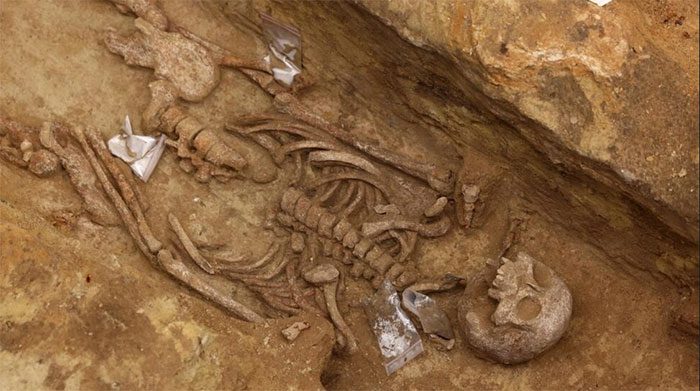Just a few meters from a bustling train station in the heart of Paris, scientists have uncovered 50 graves in an ancient cemetery.
This discovery offers a rare glimpse into life in Lutetia, the predecessor of modern-day Paris, nearly 2,000 years ago.
This buried cemetery had remained undiscovered despite extensive roadworks and the construction of the Port-Royal station carried out in the 1970s.
An anthropologist, Camille Colonna, from the French National Institute for Preventive Archaeological Research (INRAP), indicated that there had been suspicions about a burial site near the southern cemetery of Lutetia.

One of the ancient skeletons unearthed. (Source: AFP).
The Saint Jacques Cemetery, the largest burial ground in the town of Lutetia, had previously been partially excavated in the 1800s.
However, only items deemed valuable were removed from the graves, while many skeletons, burial offerings, and other artifacts were left behind.
The INRAP excavation team discovered a skeleton holding a coin in its mouth, allowing them to date the newly found cemetery to the 2nd century AD.
The excavation, which began in March, has uncovered 50 graves, containing the remains of men, women, and children believed to be the Parisii, a Gallic tribe (the ancestors of modern-day French) who lived in Lutetia when this city on the banks of the Seine was under Roman rule.
The skeletons were buried in wooden coffins that are now only identifiable by their fingernails.
More than half were buried with offerings such as vases and ceramic cups. Sometimes a coin was placed in the coffin or even in the deceased’s mouth, a common practice of the time known as Charon’s coin.
Archaeologists also found shoes inside the graves, identified by the small nails located in the soles.
The shoes were placed at the feet or alongside the deceased as grave goods.
Additionally, archaeologists discovered jewelry, hairpins, and belts.
A complete skeleton of a pig and other animals was found, believed to have been sacrificed to the gods.
Unlike the excavations in the 1800s, this time the excavation team plans to collect all items from this cemetery for analysis.
Archaeologist Colonna emphasized that this will allow for insights into the lives of the Parisii through their burial rituals.
Mr. Garcia highlighted that the ancient history of Paris remains largely unknown, and the excavated graves provide a new perspective on ancient Paris.


















































